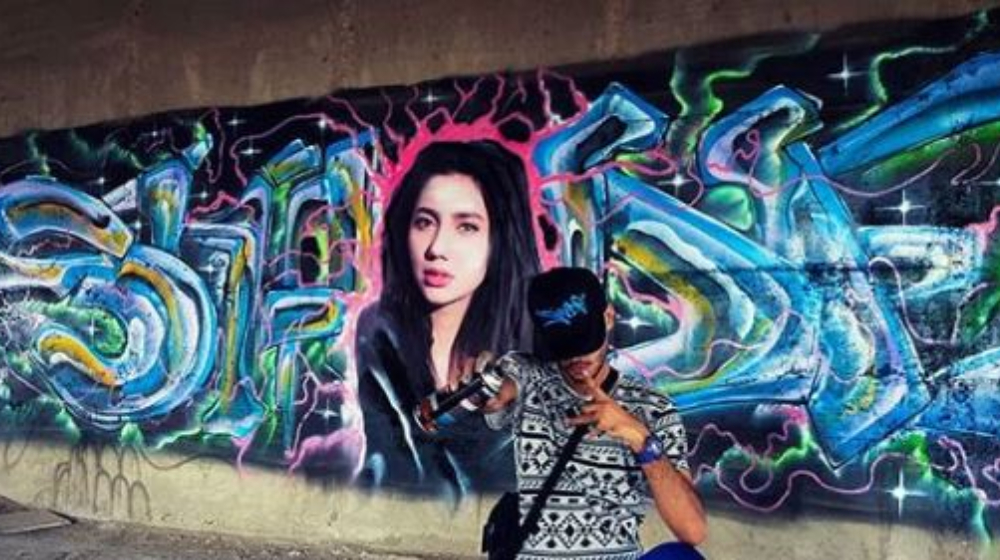Whenever we see some legitimately beautiful artwork, we’re awed by the artist who made it. For graffiti artists, recognition is not always a given (its illegal in many places after all). However, there are some graffiti artists who are fortunate to be remembered for the work they did, and step out into the light.
Neil Uchong is one such graffiti artist based in Karachi. His name may sound unfamiliar, even though he work does not. Neil is the man behind that viral Mahira Khan graffiti, as well as that sprawling artwork on Lucky Star Chowrangi.
And that’s not all this graffiti artist has done.
https://www.instagram.com/p/BpXQFxSnlQP/
His mural was even used as a backdrop in Baaji‘s song Gangster Guriya (notice the wall in the backdrop).
https://www.instagram.com/p/BuOM8bBA5YO/?utm_source=ig_web_copy_link
Neil even paints Instagram-worthy walls at eateries like Pinch & Co., D’alma and Big Thick Burgerz.
How It All Started
Neil didn’t plan to be an artist, it kind of just came to him. As a parkour traceur (practitioner) b-boying off the walls of Karachi, his shoe prints left their mark on the walls.
This gave him the idea of painting shoes on these walls, just to intentionally leave a mark. He tells that it was his trip to Sydney that enlightened him.
“Our marks would rub off because it was just dust from our shoes. So then it escalated to shoes dipped in paint to literally leave a mark and make our presence known. Basic writings and tags followed and by 2002, I had my own hand style for tags.”
https://www.instagram.com/p/Bb_nQtOnoai/?utm_source=ig_web_copy_link
His 2004 trip to Australia had him awestruck by the massive graffiti art plastered on entire walls. And that is how he set out on his journey of painting walls with art in Sydney.
“That’s when I started getting into complex pieces and productions; that’s where I witnessed large walls covered in these amazing pieces, each of a unique hand style.
I was so inspired that I went to the nearest store, which at that time was equivalent to buying drugs as graffiti was highly looked down as vandalism, not to mention was illegal. Got out of that shady store which had the cans hidden behind a curtain and then hit the train tracks.”
He then brought that craft back to Pakistan and started working with whatever cans were available here. Initially, his artwork lacked the grandiose scale he was aiming for. Neil says it still felt good though.
Self Branding
Graffiti was his outlet, so Neil kept a low profile at first. When his artwork started to stir a storm of recognition, he took up major commercial gigs. Soon enough it was a full-time job.
“As time went by and I grew as an artist who had started to get recognized in the media, doing work for major commercials. I decided to take the plunge, leave my day job and do graffiti full-time.”
https://www.instagram.com/p/BcsFFxknBop/?utm_source=ig_web_copy_link
https://www.instagram.com/p/BeLN4EnnC3E/?utm_source=ig_web_copy_link
Fame
Once he had the media’s attention, he used social media to create his own brand as an artist. He used the platform to get his work out there and turn art into a sustainable career.
“I had to bring my art to social networks in order to get more projects. Through a lot of hard work and dedication, I can proudly say that my art pays the bills, I am running my own house and life entirely off of it.”
https://www.instagram.com/p/BeNr2Uon0GW/?utm_source=ig_web_copy_link
Even with enough commercial projects in the pipeline that help pay his bills, Neil stays true to his art. This Karachi-based graffiti artist intends to keep this culture he pioneered alive, rather than commercialize it.
“The focus should be on the art and keeping the culture alive, not faking it and mixing graffiti with other things to then call it graffiti.”
https://www.instagram.com/p/Byj-1bWg7vw/?utm_source=ig_web_copy_link
via Images








